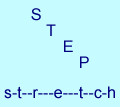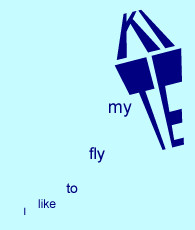Text types: Texts for fun & leisure
| Poems & rhymes |
Helping students to write poems
The successful creation of even a simple poem can increase students' confidence and ability in writing, and promote self-esteem in children with learning and language difficulties. However, it is not desirable for students to start writing poems immediately. In preparation for writing, it is important to get students accustomed to the idea of poetry as a form of communication and self expression. Many teachers have a collection of suitable poems which are read to students on a regular basis. When selecting poems for reading out loud, choose poems with strong patterns of rhythm and rhyme and aim to read each poem more than once. It is important to focus on enjoyment and personal response as well as grammar and vocabulary.
Before writing whole poems, start with simple words and ideas. To start students thinking about how we can play around with the shape of individual words, you can write some samples on the blackboard:
 |
 |
 |
Get students to think of other words which they can write creatively.
![]()
This is a fun activity for them to do in pairs. Encourage them to produce a decorated colour version for the wall display.
The next step is to help them to write short poems based on shapes. You can begin with easier structured poems, such as diamond poems, which have a distinctive shape:
 |
 |
 |
For a PrimeTask teaching activity which can provide KS2 students with practice in writing a diamond poem about fireworks, see the PrimeTask CD-ROM, Festivals and Holidays.
For a PrimeTeach teaching activity which can provide KS2 students with practice in writing a diamond poem about the weather, see:
A more creative effect is possible if you get the students to write the poem in a way that suggests the shape of the object being described or presented:

Easily recognizeable shapes (such as planets, animals, birds, snakes, trains, planes, rockets etc) can be used to generate the poem and later cut out for wall display or for making hanging mobiles.
For a PrimeTeach teaching activity which can provide KS2 students with practice in writing a poem about the planets, see:
An easy poem for students at this level is the acrostic. An acrostic works like this: you choose a word such as a name or a descriptive adjective, and write it vertically, either down the left hand margin of the page or in the middle. Then you use each letter to begin a line which relates to the theme of the poem. Here is an acrostic on the theme of 'school':
Scary,
Chaotic,
Hellish,
Oh no!
Oh dear!
Let me out of here!
If you want to encourage your students to develop multi-media skills you can
get them to illustrate and/or animate their poem and include a range of
appropriate sound effects. If students have access to computers you could post these
'action poems' on a website. For an interesting classroom website with poems,
stories and other projects see:
http://www.edleston.cheshire.sch.uk/projects/projects.htm
Reading and writing poems can be useful for recycling vocabulary and grammatical structures. Students are more likely to be motivated to write if they know why they are writing the poem in the first place, so make the language learning purpose clear. Is the focus on a vocabulary set, on a grammatical structure, on sounds and letters of the alphabet, on metaphor, on idiom, on pronunciation?
Different students will get different things out of writing poetry. Some will get pleasure from expressing meaning, others from playing with language for the fun of it. Note that not all poems have to rhyme, in fact rhyme is quite difficult for students to master, and it is not worth overly emphasising this aspect of poetry.
Children enjoy the nonsense element of poetry and this can be exploited to encourage creative language use. You can also encourage them to invent new words (eg to spide = to walk like a spider, big + ugly = bugly).
When you are correcting students' poetry (indeed, any of their writing) it is important to pay as much attention to the ideas and personal expression as to the grammatical accuracy and layout.
When you have got your students to write poems of their own, you might also like to consider posting their poetry in the TeleNex poetry corner!
|
Tell me more! Why should students read poems? |
|
Sample texts Some nursery rhymes |
|
||
To give us feedback about this section, click here or on the Comment button at the top of the screen.
If you have any questions about this section, visit the Language Corner.
If you have any questions or suggestions about how to teach this section, send a message to the Teaching Corner.